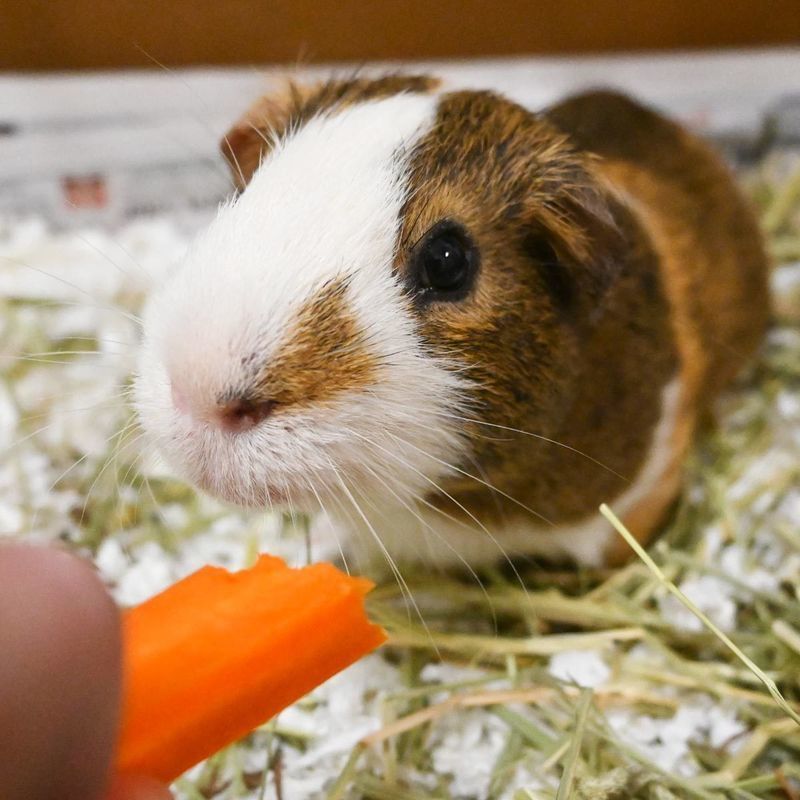Background
Also known as: Domestic rat (a descendant of the wild brown rat).
Weight: Males, 1 to 1 ½ pounds; females, ½ to 1 pound.
Length: 14-18 inches, including tail.
Lifespan: 2 to 3 years.
Cost per year: $300.
Good with kids? Great for families with children 5 and up, but young caretakers should be supervised by an adult.
Fun fact: When rats are very content, they grind their teeth.
Food
High-quality rodent chow should be available to your pet at all times. Look for a brand with soymeal as a main ingredient. Tri-County Humane Society’s store sells rodent chow, and all the proceeds go back to the animals.
Fresh, clean water should also be available to your rats 24/7. A water bottle with a drinking tube that attaches to the cage is the best way to go.
Offer small, bite-sized bits of fresh fruits and veggies daily. Recommended: Peas, broccoli, carrots, apples and bananas. Avoid: Chocolate, corn, candy, caffeinated beverages, cheese, sticky foods such as peanut butter.
Rats love people food, and you can give yours the occasional table scrap, such as cooked pasta or a bit of pizza crust. But limit treats or you’ll have a chunky rat.
Cage and Environment
Rats are very social and should be kept in pairs at a minimum. A pair of females is recommended for first-time pet owners. Males can do well together if introduced when young. Females are more accepting of new friends later in life.
A neutered male can live with females, or a spayed female can live with males. Don’t keep intact males and females together, as they will breed. The average litter ranges from 12 to 20 babies!
Solid-bottom, powder-coated wire cages are recommended. 2’ by 2’ by 2’ is the minimum size for a pair of rats, but do get the largest cage you can afford. You can also use a large, multi-level ferret cage or an aquarium with a screen cover for adequate ventilation.
Rats are prone to colds and heatstroke. Keep the cage indoors, away from drafts, direct sunlight and extreme temperatures, in an environment maintained at 60 to 80 degrees Fahrenheit. A room where the family gathers in the early evening is ideal – your gregarious pets will love it!
Line the cage with bedding. Do not use cedar or pine chips, which contain oils that are dangerous to rats. Provide shredded paper towels or napkins if your rats like to make nests.
Your pets will need a cave for sleeping and resting. Try a small flower pot or box.
Behavior and Handling
Rats are friendly and curious by nature, but you’ll need to get your pets used to you and used to being handled. Start by feeding them small treats. When they’re comfortable with that, pick them up one at a time, one hand supporting the bottom, the other over the back. When you get to know each other better, don’t be surprised if your pets want to snuggle or sit on your lap or shoulder.
Once your rats are hand-tamed, let them play outside the cage in a safe, secure area for an hour every day. Out-of-cage playtime is mandatory. It will keep your smart, active friends mentally stimulated and physically fit. Supervise at all times; rats will chew on everything, including electrical wires.
Exercise and Toys
A bored rat is an unhappy rat! Provide PVC tubes for your pets to run through, and ladders and trees branches for climbing. Parrot toys, including swings and ropes, are great for rats.
Some rats love exercise wheels. Get one with a solid surface without wire rungs, so your pets’ tails cannot get caught while running.
Give your pets appropriate chew toys to help wear down their teeth, which grow continuously. Recommended: Unpainted, untreated wood, dog biscuits, safe cardboard and rawhide chews.
Daily Care
Throw it out. Remove soiled bedding, droppings and stale/uneaten food. Clean and refill the water bottle every day.
Keep it fresh. Clean cage completely once a week by replacing dirty bedding and scrubbing down the rest of the cage with warm, soapy water.
Signs of Illness
Bring your rats to the veterinarian annually. Don’t wait for your yearly appointment if you think one of your rats is sick. Common signs something isn’t right include sneezing, lethargy, weight loss, dull eyes, open wounds, diarrhea and difficulty breathing.
Rats are susceptible to external parasites such as lice. If you think your pets are infested, consult a veterinarian.
Rat Supply Checklist
Wire cage, large aquarium with screen cover or multi-level ferret cage
Aspen or pelleted recycled paper bedding
Small boxes or flower pots
Tree branch for climbing
Exercise wheel (solid, no rungs)
PVC tubes for tunneling
Rodent chow (also called rat blocks)
Attachable water bottle with drinking tube
Unpainted, untreated piece of wood, dog biscuits or safe chew toy
Toys, including swings, ropes and other toys made for parrots
Source: Information from the American Society for the Prevention of Cruelty to Animals









